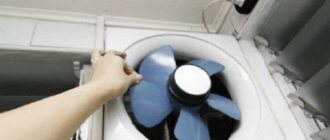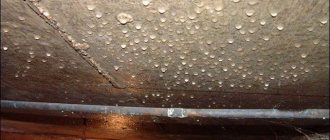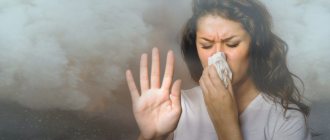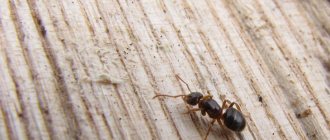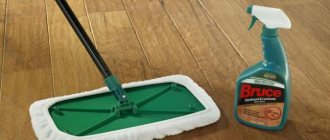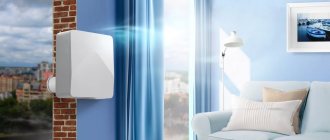The problem of damp corners and walls often worries both residents of high-rise buildings and owners of private houses. Due to the fact that the corner of the room is damp, the walls begin to darken, the wallpaper peels off, mold appears, and the air in the room becomes heavy. Plus, during the cold season, the temperature in the rooms drops, windows are opened less often to ventilate the room, a lot of precipitation falls, and the walls themselves are not dried by the sun's rays.
Damp corners and walls are a fairly serious problem that should be addressed immediately. Damp indoors can cause various diseases and also become a gathering place for fungi and mites.
Therefore, the question of why the corners in the house become damp worries many.
How to reliably get rid of increased dampness in a private home
High humidity in a living space threatens not only the normal condition of furniture and household appliances, but also the health of its inhabitants. At the same time, even modern construction and repair technologies do not always guarantee an acceptable internal environment. Therefore, the question of how to get rid of dampness in the house is still relevant today.
- 1. Simple causes of excess humidity
- 2. Hidden factors of an unhealthy environment
- 3. Unsafe plastic
- 4. Folk remedies come to the rescue
First you need to understand why the walls in a private house become damp.
It will be possible to figure out what to do only after a complete analysis of the situation. As a rule, the reasons are visible. In such cases, eliminating them yourself is not difficult. Increased humidity levels can be explained by the following simple factors:
- Leaks in the plumbing or sewer system. You just need to eliminate them using insulating materials or replace the pipes in problem areas.
- Insufficient ventilation. It is determined by a change in well-being - it becomes difficult to breathe. The room requires additional ventilation. Once a day you need to create a draft for 10-15 minutes or install a hood. This is especially true for places where there is a lot of moisture by definition. This is a bathroom, kitchen, toilet.
- Hanging large amounts of laundry to dry inside the house. It is necessary to reduce its volume, dry it outside, and in winter pre-freeze it there.
- Too much with aquariums. For them there are also special rules for care and operation (including the number in the premises) that must be followed.
- Growing flowers, growing seedlings. The number of indoor plants must be reduced to a reasonable minimum. For seedlings, it is better to use a greenhouse or greenhouse.
- Failure to comply with food preparation technology. At least you shouldn’t use all the burners for this at once.
- Open storage of any liquids. Jars, pans, and barrels must have lids.
Article on the topic: How to properly assemble a house from laminated veneer lumber
Often an excessively humid background is formed due to incorrect temperature conditions in the room. The house needs to be heated, even if no one permanently lives in it during the cold season. Otherwise, temperature changes will quickly lead to plaque on the walls, the appearance of fungus, and damp corners.
Sometimes it is difficult or almost impossible to determine the causes of problems without involving a specialist. Especially if they were laid during improper construction and violations committed during it. Then only a professional will advise how to deal with dampness in a private home.
A hazardous environment can form in housing due to the following reasons:
- The plumbing, water supply, and sewage systems are installed incorrectly: proper insulation is not done, there are too many intertwined wiring, cold water and hot water pipes are located extremely close. The solution is to replace at least one of the systems first.
- Lack of proper ventilation in the basement or attic. It is necessary to install special vents.
- Incorrect installation of foundation and roof moisture insulation. In the summer, it is necessary to dry them and protect them using special materials.
- Cracks in the walls and foundation. Simply covering them with cement mortar or filling them with foam is not the solution. You must first at least treat them with neutralizing and then water-repellent solutions.
- Improper operation of the storm drain, its clogging or damage. You will have to repair or replace the system.
- The walls are too thin. You need to at least insulate them. You can make additional external cladding, providing an air plug.
- Breaks in the seams. If the house is wooden, they need to be cleaned, treated with neutralizers and caulked again. If it is brick, after preliminary preparation the seams must be cemented.
- Use of low-quality materials in repair or construction. In the first case, the solution is obvious, in the second, negative factors can only be reduced by using additional sealing, insulation, and ventilation (unless, of course, the housing is rebuilt). A wooden house can be completely dried.
- Insufficient, incorrect blind area. It should be redone, providing for a normal slope, and taken outside the roof perimeter.
Article on the topic: How much will a two-story brick house 10x10m cost?
Another serious factor contributing to the appearance of dampness is that there may be groundwater very close to the structure. With this option, it will be necessary to strengthen the foundation and install waterproofing. You can also make drainage by digging a trench around the house.
When discussing how to remove moisture from your home, you should keep in mind that plastic windows are easy to use , relatively cheap and look good. But their installation carries many restrictions on the use of the room (cooking, washing, drying, ventilation). In addition, these blocks may be of poor quality, and their installation was carried out improperly and using poor seals.
When installing and operating fiberglass blocks, it is necessary to consider:
- The room must have sufficient natural ventilation.
- When choosing windows, it is better to immediately choose blocks that have special valves that act as vents.
- If windows that do not have valves are already installed, then vents can be installed in them.
- Rooms with plastic blocks must be ventilated at least twice a day.
- When installing the window sill, you need to make sure that there are no gaps between the frame and the walls.
Different types of windows have different operating rules that must be studied and followed. This also applies to “winter-summer” systems: you should not neglect switching the modes of locking devices suitable for a particular time of year.
Methods for eliminating dampness in the house depend on the reasons for its occurrence. You need to focus on the fact that the standard indoor humidity for people varies from 40 to 60 percent. A special device called a hygrometer will help you accurately determine the parameters. But to determine risk factors and combat negative manifestations, there are also folk remedies.
Depending on different conditions, you can try using the following tricks:
Article on the topic: How to properly insulate a brick house
- The ventilation condition can be easily checked using a candle. If the light goes out or dances, then ventilation is in progress. If the flame does not move, then it’s time to look for the reasons for air stagnation. You can use a match instead of a candle.
- High humidity in the room is checked using a plastic bag. It is attached to the wall with electrical tape or tape. After a day, the package is removed. If the wall underneath is dry, it’s not the wall, but the ventilation.
- A stain on the ceiling most likely indicates a roof leak. The emergency location should be looked for near the wet mark.
- If mold is found, it is not enough to remove it. After cleaning, the affected surface must be subjected to therapeutic and prophylactic treatment. A solution of potassium permanganate or laundry soap, soda or bleach, alcohol tinctures or solvents, hydrogen peroxide or vinegar are suitable for it.
- If fungus has infected the wallpaper, it will have to be removed and the walls re-plastered.
- Hot bricks and bags of heated dry sand will help get rid of dampness for a while. They should be placed indoors and replaced with new ones when wet.
It must be remembered that high humidity increases the risk of colds and acute respiratory infections. The fungus can lead to diseases such as bronchitis and asthma. When thinking about how to remove dampness from your home, you need to remember this.
Diseases, allergic manifestations, weakened immunity are often the consequences of unhealthy microflora in the home. Dampness destroys the structure itself. Therefore, it is better to engage in timely prevention, identification and elimination of the causes of high humidity, rather than encounter even greater problems in the future.
The principle of eliminating the problem
Eliminating freezing of a house or a separate part of it is not so simple.
As a rule, the most common places for such problems to occur are the corners of the building.
They are the ones that are most susceptible to various deformations and may contain voids that arise due to the junction of two walls. The only way to get rid of wall freezing is to shift the dew point back towards the street. A similar effect can be achieved in one single way - complete thermal insulation of surfaces.
Such a procedure requires a huge investment of time and effort, and also costs a lot of money. However, this is the only way to be sure of achieving a positive effect. In addition, complete insulation of the house will not only make it warmer, but will also make it possible to save money on heating.
You can insulate a freezing wall using ecowool or polyurethane foam.
For those who do not want or cannot shell out a tidy sum for thermal insulation of the entire building, there is a more economical solution. It consists of spot insulation of corners or walls. A similar option is not as effective as creating a dense monolithic thermal insulation layer, but can also be beneficial. In some cases, insulating a small part of the wall is quite enough to remove condensation from its inner surface.
You can achieve the desired effect in several ways, which look like this:
- use of polyurethane foam;
- use of special heat-protective plaster;
- direct insulation with thermal insulation materials.
Each of these methods is capable of eliminating wall freezing, but the effect of spot thermal insulation is quite small and cannot guarantee complete insulation of the room.
Moisture in the house. Condensation on the windows and leaking corners of the walls. Why and what to do.
Many are already preparing for renovations in completed houses, and some have already begun finishing. And, probably, many have encountered such problems as condensation on windows, wet corners, etc.
Naturally, it is impossible to carry out work in such conditions, at least not on plaster. But there is no time to wait and the question is how to fix this problem and what is the reason.
Article on the topic: How to properly build a brick bathhouse
First, let’s define what time of year we are talking about.
Spring Summer
If it is already a very warm spring or summer,
then first of all the problem should be looked for in cracks, crevices, in the lack of tightness where it should be. Walls, corners and slopes will get wet after or during rains.
For example, when it comes to corners, the leader can run from anywhere.
The first thing you need to do is inspect the façade for cracks in the masonry or plaster. It is also worth mentioning that if you have not yet finished the facade during block construction, then, for example, during heavy rains, the gas block may simply pick up moisture.
But if the finishing is done, then there is only one option - to look for a crack.
The weakest point in this regard is the angles of both leakage and freezing in winter.
Of course, it is better to seal it from the outside. But it won’t be amiss from the inside either.
Winter
Such problems very often arise in winter both in apartments and in private construction.
Let's look at the most common situations.
We insulated the loggia in the apartment, but it began to leak.
Let's start with the fact that if the loggia is designed as cold, then the glazing is appropriate. By changing the glazing you are already disturbing the microclimate of the loggia. It gets warmer indoors, but frosty outside.
What's going on?
Look at the ceiling in the photo. This is a concrete slab, the end of which faces the street and freezes at low temperatures. And nothing would have happened if you had not touched the loggia. But you changed the glazing, insulated it and created a room inside with an unacceptably warm temperature, which led to the formation of condensation.
Look, the wet ceiling is only near the window. Because closer to the room the stove is heated, but at the edge it does not warm up, because... its end is on the street and at this point it always remains cold and will always get wet when it comes into contact with the warm air of the loggia.
Article on the topic: How to properly screed a garage floor
What to do?
It is necessary to cut off warm air from the cold stove. In simple terms, you need to make sure that at the point of contact of the slab with the thermal insulation there is approximately 0″. That is, we remove the point of contact -10 from +18.
In this case, it is better to make insulation not from thick thermal insulation, but multilayer, but of sufficient thickness.
Concrete beams in the house and corners get wet
We continue to talk about winter. As soon as you bring heat into your new home, you will see this picture.
This is the same story as with the balcony ceiling. Armored belt, floor slab, ends of beams: all this must be insulated. If you don't do this, the result will be obvious.
But even with proper installation, you can see such a picture when you start heating the house. If the temperatures are extremely low, and the house does not yet have exterior finishing, which also includes insulation of the facade, but when the temperature drops to 0 or when the house warms up, the corners will, of course, get wet for some time.
This is how these units should be assembled.
Therefore, carefully monitor the construction at this stage or ask for a photo-video report from the workers.
If it hasn't been done. Open - execute.
If all the rules during construction are followed, then insulating the facade will help completely eliminate this nuisance.
In the meantime, all you have to do is wait for it to warm up and dry.
Condensation on windows
This clearly indicates increased humidity in the room and, in some cases, a violation of ventilation and vapor barrier.
If plastering, screeding or puttying work is underway in an apartment or house, then there will definitely be condensation. In this case, ventilation will help.
If wet work is not carried out, then your ventilation is compromised.
Natural ventilation involves air entering through windows and doors and air being exhausted through ventilation ducts.
We are used to installing forced fans and hoods above the stove, thereby blocking the ducts and disrupting ventilation; the fans and hoods are not always on, and when they are turned off, the vents are blocked.
- If you want to install a fan, then make another outlet that will be free and open.
- If you install a hood, then make another exit in the kitchen that is free and open (with a grille)
- When installing doors, leave under the door gaps, and do not try to minimize them, as this also disrupts the air circulation in the house or apartment.
Article on the topic: Is it possible to build a half-brick fence?
Some ways to eliminate freezing symptoms
You should not immediately take measures to insulate the room - simple insulation, especially from the inside, will not give practically any effect, but will only shift the dew point, and the moisture will condense elsewhere.
For example, cold air will come into contact with warm air indoors. And this will significantly worsen the situation.
Advice. The problem is identified, as a rule, in the cold season, but it must be solved in the warm season, when it is possible to thoroughly dry the house as a whole and problem areas in particular.
The best option:
- sealing seams;
- thermal insulation of the facade;
- thermal insulation of the foundation.
Although thermal insulation of the facade is unlikely to be possible if the facade is lined with decorative or facing bricks. In this case, the only way out is to carry out internal insulation work.
Although their effect is much lower, if they are performed correctly, this will solve the problem associated with freezing of corners and walls.
Insulation and insulation of problematic walls and corners inside the house
If a problem appears in the house after all the finishing work has been completed, most likely you will have to do the repairs again, since cosmetic measures will not give results.
The following work needs to be done:
- remove wallpaper, plaster;
- unstitch the seams;
- treat seams and walls with antifungal compounds;
- The next serious operation is how to dry a brick house, that is, dry the walls and the room itself . For this, it is best to use heat guns, but household heating devices can also be useful;
- re-fill seams, voids or cracks that have appeared with polyurethane foam, liquid foam compositions, you can use so-called “warm” types of plasters , which contain particles of expanded polystyrene, which have high heat-insulating properties;
- cleaning treated seams and surfaces and preparing them for plastering work;
- performing plaster, most often several layers are required, for the first, again, you can use the same “warm” plasters , but you can also use regular plasters, but with the addition of hydrophobic additives, the instructions detail how to use them;
- Additionally, you can apply a layer of liquid insulation with excellent adhesion characteristics . Outwardly, it resembles paint and is applied with a roller or brush. In addition to its main function, it has both antifungal and anti-corrosion characteristics, which allows this material to be used, for example, for anchoring ventilated facades, significantly eliminating the effect of “cold bridges.”
Application of non-standard architectural and design techniques
There is an architectural way to avoid the formation of so-called geometric “cold bridges” - the construction of beveled or rounded corners of the building. But not everywhere, for obvious reasons, this method can be applied. However, it is quite possible to install pilasters or other decorative elements on the façade.
If a corner in a brick house gets wet, for the same purpose, when installing a multi-level ceiling, you can make a special box or niche into which to mount the lighting.
In operating mode, this is an excellent heating device for warming up the air, and thereby moving the dew point from the room deeper into the wall or even closer to its façade. The vertical version of this design can be arranged similarly.
Possible causes of dampness
To understand how to eliminate the appearance of damp spots in corners, it is necessary to determine the causes of the troubles that have arisen. There are quite a few of them, but they are all divided into internal and external. In this case, the entry of moisture into the room can be hidden or obvious.
Among the internal reasons are:
- insufficient heating of the room;
- poor ventilation in the bathroom and kitchen;
- frequent drying of washed laundry inside the apartment;
- insulation from inside the room;
- recently carried out renovations, after which the walls have not yet dried out;
- poorly installed windows and window sills;
- pipe leaks in ceilings, walls or floor screeds;
- formation of condensation on pipes and air ducts due to lack of insulation.
External reasons for a damp corner in the house include:
- freezing of walls as a result of violation of the integrity of thermal insulation;
- moisture ingress due to damage to the roof, breakdown of the drainage system or leaking pipes in the attic;
- high humidity in the basement;
- poor quality foundation waterproofing;
- cracks in the walls and unfilled seams;
- voids at the junction of the balcony slab.
As can be seen from the above reasons, the supply of moisture may depend on the floor, the location of the apartment and the wear and tear of building structures.
Base
As for the above-ground part of the foundation, in addition to vertical waterproofing of the base, there is also horizontal waterproofing (to prevent capillary rise of water to the walls). This is done during construction using bitumen tape or special solutions.
If the walls of the first floor begin to become damp from below, it means that this protection no longer “works.” You can cut off the penetration of moisture by injecting a specially penetrating solution, which will fill the micropores in the base material.
To do this, holes are drilled along the perimeter of the house (below the floor slab level of the first floor) at an angle of 30 degrees to the ground level, in increments of 15 cm (7 pieces per 1 meter). They should not be through (5-8 cm to the surface). If there is access, for thick walls you can make a second row from the inside, offset from the first row. The sanitizing solution is pumped either using a special “syringe” or by gravity (based on the dropper principle).
In some cases, the cause of wet walls on the first floor may not be the capillaries of the base material, but the masonry joints of the foundation, if it is made of brick or blocks. Therefore, holes for injection of mortar must be made in the seams.
The problem of a wet foundation always exists, but more often it is encountered after winter. If there was a lot of snow, there will be a lot of water in the spring. As a result, meltwater floods the foundations of houses and accumulates underground.
Melting snow also causes groundwater to rise. And if you live in an area with their occurrence close to the surface, then the risk of flooding increases significantly. Therefore, at the end of winter, it is important to inspect the site and the subfloor of the house and drain melt water from the base of the building.
However, a snowy winter is not the only reason for a wet foundation. It may get wet due to:
- Violations of construction technology. The desire to save money is the main enemy of quality. Often, site owners decide to pour the foundation themselves, because the process does not seem too complicated, or they hire a team of handymen who have no idea about building regulations and technologies. This could end up becoming a serious problem. If you do not completely dry the concrete foundation of the house, cover it with waterproofing and immediately fill the barely set monolith with expanded clay, sand or other insulation, all materials will be wet. The moisture from them does not evaporate due to the screed; it will gradually rise, capturing the walls and floor. In addition, such a foundation will freeze in winter, since the water contained in it will crystallize, increasing the foundation in size. As a result, this will lead to cracks in the concrete foundation, internal and external waterproofing and an increase in the volume of water penetrating into the house.
- Break of communications in the basement. Often the communications of a house are concentrated in the basement. Water supply, sewerage, and heating pipes may run there. If they break, water very quickly fills the underground, and at the same time penetrates into the foundation. Unfortunately, simply pumping out the liquid is not enough; it is necessary to do high-quality drying.
- Absence or improper design of storm drainage system. Seasonal precipitation can significantly damage the foundation of a house. If there are no storm drains, or they cannot cope with the flow, the water is not drained away from the house, but accumulates at the foot of the house.
- Other reasons causing moisture accumulation at the bases of buildings.
If you encounter one of these problems, immediately call the dehumidifier team of Sinus JSC. The consequences of flooding must be eliminated as soon as possible. Call +7 495 681-73-61, we are always in touch!
How to get rid of dampness depending on the cause
After determining the reasons why the walls in the house become damp, you can determine ways to eliminate dampness on the walls of the house and begin to eliminate the shortcomings. Sometimes you can do this yourself, but more often you have to turn to specialists, especially if it involves working at heights and roof repairs.
Article on the topic: What is a gazebo in VK
Freezing of walls and insufficient heating. Insulation of the room should be done from the outside, inviting industrial climbers for this. Insulation from the inside will almost certainly lead to a shift of the “dew point” to the middle of the building structure. As a result, the flow of moisture through the wall can only increase.
The specialists you contact for help will be able to perform the necessary thermal calculations and determine the thickness of the thermal insulation layer and the efficiency of the batteries. If the heating system operates unsatisfactorily, it can be recommended to increase the heat transfer area of the heating devices without abandoning the external insulation of the walls.
Ineffective ventilation. The absence of a hood with new sealed windows can lead to condensation and moisture settling in the walls. In this case, it is recommended to ventilate the room through slightly open windows. Another effective way would be to install a low-noise fan in one of the exhaust ducts. Electricity consumption in this case will be minimal, and the effect will be noticeable.
Roof leak. If you live on the top floor, start looking for moisture ingress by inspecting the attic or flat roof. A roof leak is often the cause of dampness in an apartment. It is clear that in this case only urgent roof repairs can help. And if you can’t do it yourself, then you shouldn’t save. Call a roofer.
Poor quality waterproofing of the foundation. This reason is found in private houses. The deficiency can only be corrected from inside the basement by introducing injection waterproofing materials. If there is no full basement in the house, you will have to dig out the foundation and use coating or rolled materials.
The junction of the balcony slab and loose joints. The best option is to make high-quality glazing for the balcony and seal the cracks with sealant. Assembly joints between slabs in panel houses should be sealed by industrial climbers who have experience working at heights.
The upper corners of a private house are damp. This happens because the attic is poorly ventilated. Condensation forms and drops roll down the vapor insulation. The field of this moisture penetrates into the room.
Article on the topic: Who is Bani men?
Is it worth insulating a corner from the inside?
Owners of country real estate and city apartments prefer to immediately cover the problem area with sealant, putty, or seal it with all kinds of thermal insulation materials. Unfortunately, such measures will only help if the corner is frozen quite a bit, which is rare. You also need to understand that a heat insulator laid from the inside will block not only cold, but also heat. Insulation can only make things worse, since it will cause the dew point to shift to the inside of the wall. As a result, cold air will freeze the wall right through, because the heat insulator prevents the heat from the house from warming up the concrete, brick or wood a little. As a result, the wall material will only begin to deteriorate more intensely, and the problem will be solved in a very short time.
We recommend: For which rooms are pendant lamps suitable?
But sometimes facade work is simply impossible to carry out. In this case, it is also recommended to take into account some nuances.
What to do if nothing helps
If you have tried to eliminate wet walls and the appearance of damp spots, but your actions have not brought positive results, contact the management company. To do this, you must write an application in two copies, one of which must be registered with the Criminal Code.
After this, the management company is obliged to send a specialist to inspect the premises and draw up a report on the presence of moisture. The same act must identify the cause of the dampness and set a deadline for its elimination.
Builder mistakes
Unfortunately, an equally common cause of freezing corners in an apartment building is the negligent attitude of builders to their work. Shortcomings and violations of technology are manifested in the so-called cold bridges. Due to savings on mortar or insulation, poor-quality masonry, voids and cracks appear in the walls through which cold air enters the room. At the point of transition from warm to cold temperature, a cold bridge is formed, which causes condensation on the surface, the consequences of which are manifested in freezing corners and the appearance of mold.
Preventing dampness
To prevent the walls from becoming damp again, it is necessary to reduce the amount of incoming moisture. For this:
- do not dry clothes inside the apartment, use a balcony or loggia;
- keep the ventilation grilles clean;
- at the lowest outside temperatures, use additional heating devices;
- in a private house, insulate the attic and ensure its ventilation;
- Ventilate the premises more often.
Install a fan with a built-in humidity controller on your bathroom hood. When the moisture content in the air increases, it will turn on automatically.
Korovin Sergey Dmitrievich
Master of Architecture, graduated from Samara State University of Architecture and Civil Engineering. 11 years of experience in design and construction.
- How to calculate how many cubes of concrete are needed for the foundation?
- Self-construction of the roof of a private house
—>
Damp wall
Dampness on the walls can appear for several reasons. The main indicator of dampness in a wall is mold. A damp wall is formed from three main reasons:
- External leaks
- Poor thermal insulation
- Lack of ventilation
Dampness on the walls creates a favorable environment for the growth of mold and creates an unfavorable environment for human habitation. The main negative factors of damp walls in a room are:
- Heat leakage and increased energy consumption for heating a room with damp walls.
- Active reproduction of fungal and mold spores.
- Decreased immunity and exacerbation of chronic diseases of the human body due to uncomfortable temperature and humidity conditions in the room and the active reproduction of fungal and mold spores.
Our specialist will help you correctly determine the cause and give further recommendations - how to remove dampness from the walls and how to treat the walls against dampness. Determining on your own the reasons why your wall is damp, without the appropriate equipment, can lead you down the wrong path of further action. Savings on diagnostics will definitely affect your wallet, since any construction work to eliminate dampness in our time is not very cheap.
Causes of damp walls in the apartment and corners in the rooms: ways to combat mold
In houses or apartments, a situation often arises when corners or walls begin to become damp.
As a result, the wall darkens, the wallpaper begins to peel off, and a characteristic smell of dampness appears in the apartment. Such consequences do not add to the attractiveness of the room. But besides this, a damp surface in a room is an ideal environment for the development of mold. And fungal spores are the cause of the occurrence and development of numerous respiratory tract diseases. What is the reason for the appearance of moisture on the surface of the walls, and how to deal with this problem? What causes dampness in an apartment?
Reasons may be:
- external;
- internal.
Foundation waterproofing
It happens that dampness in the house is caused by the fact that the foundation is poorly insulated. If its waterproofing is insufficient, groundwater when raised above 1.5 m can penetrate into the walls. In this case, they will get wet, mold will appear under the baseboard and in the corners, the plaster will begin to fall off, and the wallpaper will deteriorate. However, if horizontal waterproofing of the foundation is done correctly, it can prevent the penetration of groundwater.
Why does the foundation get wet?
External moisture
The cause of dampness can be external moisture falling on the walls and penetrating through microcracks or poorly sealed seams inside. More often, such a nuisance is typical for apartments on the upper floors with a poor-quality drainage system, for walls along which drainpipes run, as well as panel houses with poorly sealed joints between the slabs.
Article on the topic: How to cover the facade of a wooden house
moisture in corners
In order to eliminate the problem, it is necessary to clean the wall of the old coating, re-plaster it from the outside, prime it, cover it with waterproofing mastic, and only then completely paint the resulting surface. You can independently carry out such a cycle of operations either in a private house or on the first floor of an apartment building. In other cases, solving the problem of damp walls on your own will be very problematic due to the need to carry out high-altitude work. Therefore, you will have to turn to professionals.
Which insulation to choose
An example of the technology for insulating an external wall.
As soon as the defects of the brick wall are eliminated, you should begin to decorate it externally. It will serve as insulation and a solution to the problem of freezing corners for many years. The same applies to panel houses. They are also insulated, no matter what floor the apartment is on, although here the choice of materials is limited.
Not every siding is suitable for a panel or multi-story building, since the finishing material must fit into the architecture of the house and not disturb it. The entire list of insulation materials is given in the table.
Table 2. Types of insulation for exterior decoration of a house:
| Name | Description |
| Thermal insulation plaster | Most often used for exterior decoration. It has a high vapor permeability rate, so condensation will not form inside the home. Contains particles of polystyrene foam, not sand. |
| Liquid thermal insulation | Acrylic-based compositions, whose properties are identical to mineral wool insulation. Apply in 1 or 2 layers. Such liquid insulation may also contain antifungal components. Thanks to them, mold will not form in the corners. The composition is quickly applied. Adheses well to almost any surface. |
| Thermal panels | This includes siding and sandwich panels. The latter are finished in the form of decorative bricks, imitation of the texture of natural stone and other options. Thermal panels are applied directly to the external wall. Sometimes a frame of profiles is pre-assembled. The material is easy to cut and quickly attached to the surface. No additional preparation required. |
| Mineral wool | A classic insulation method that is gradually becoming a thing of the past. There are a lot of ways to do this type of finishing. For example, first the mineral wool itself is laid along the wall, then corrugated board or siding is attached on top. |
The usual polystyrene foam is also used, on top of which a layer of plaster is applied. This is a cheap method of insulation, used not only in brick, but also in panel houses. In the latter, it is used much more often, since it allows not to disturb the overall appearance of the house. Different thicknesses of foam are used, which determine the degree of insulation. When performing work, it is important to eliminate gaps between joints. Otherwise, cold air will pass through them.
Prices for thermal insulation materials
Thermal insulation materials
Excessive indoor humidity
The simplest reason, in terms of elimination, is high humidity in the apartment.
It is possible that the appearance of pockets of dampness was preceded by the replacement of windows in the room. New windows closed the openings more hermetically and worsened the ventilation of the room. In some cases, in order to avoid dampening the walls of the apartment, it is enough just to ventilate the room more often. If this is not enough, or the problem occurs in a room with potentially high humidity, for example, a kitchen, then you can try to improve the quality of ventilation. To do this, you can put a fan on the vent. Thus, ventilation will turn from natural into forced supply and exhaust with greater productivity.
Some nuances of sealing joints
If the tightness of the seams is broken and cracks appear in the walls, the corners in the room begin to become damp. In this state of affairs, there is only one way out: the waterproofing of the joints between the panels needs to be repaired, and microcracks in the walls need to be repaired.
After high-quality sealing, the walls should not gain moisture. They can become damp and leak only when the technology for sealing the seams is broken.
The main mistakes are applying sealant without prior repair or using a low-quality sealant.
This should also be taken into account: if waterproofing of joints is carried out in one apartment, and not in the whole house, then the problem of dampness will not disappear. Moisture will penetrate into poorly sealed seams in an apartment on the floor above or on the technical floor, so although more slowly, it will find its way into the desired room.
Guarantee for work done
Legal entities that contact us receive a guarantee for all work performed for a period of 5 years. In this case, the complexity and volume of work done does not matter. In the case of individuals, the warranty period is from 2 years.
The difference in the warranty period is that order volumes for legal entities are always higher. For individuals, after the expiration of the warranty for the work performed, there is the possibility of preferential maintenance of the building. As for the estimated service life of the materials, it is 15 years.



